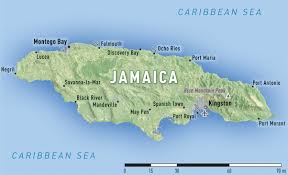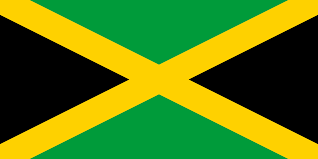
Jamaica
.
.

Trackchasing Country #14
Greetings from places on the way to and from Brown’s Town St. Ann, Jamaica. Click on the links below to read about the “story” and see the photos and videos from this trip to a small Caribbean country, Jamaica mon, home to my trackchasing country #14.
The introduction
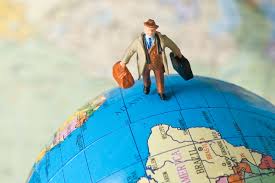
WANTI WANTI CAN’T GET IT, GETTI GETTI NO WANT IT TRACKCHASING TOUR
SPECIAL NOTICE!
This afternoon I saw racing in my 14th different country. Below is a list of when and where I saw first saw racing in each of these countries.
SUMMARY OF “COUNTRY” TRACKCHASING ACHIEVEMENTS
# 1 – UNITED STATES OF AMERICA – Peoria Speedway (Mt. Hawley) – Track #1, Peoria, Illinois – circa 1954 (age 5)
# 2 – CANADA – Cayuga Speedway – Track #174, Nelles Corner, Ontario, Canada – July 31, 1988 (Dick Trickle winner)
# 3 – UNITED KINGDOM – Northhampton International Raceway – Track #378, Northhampton – June 26, 1999 (accompanied by Carol, Kristy, Jim)
# 4 – AUSTRALIA – Speedway City – Track #804, Virginia, South Australia – December 26, 2004 (accompanied by Carol)
# 5 – NETHERLANDS – Driesum Racetrack – Track #839, Driesum – May 5, 2005 (accompanied by Roland Vanden Eynde)
# 6 – BELGIUM – Bellekouter oval – Track #841, Affligem – May 8, 2005 (accompanied by Roland Vanden Eynde)
# 7 – FRANCE – Circuit de Croix en Ternois – Track #843, Saint-Pol sur-Ternoise – May 8, 2005 (accompanied by Roland Vanden Eynde – 2ndnew country in one day!)
# 8 – GERMANY – Nurburgring – Track #844, Nurburg – May 13, 2005 (accompanied by Carol, Roland Vanden Eynde)
# 9 – NEW ZEALAND – Western Springs Speedway – Track #1,134, Western Springs – December 26, 2006 (accompanied by Carol)
# 10 – MEXICO – Triovalo Bernardo Obregon – Track #1,281, Tiajamulco de Zuniga, Jalisco – October 14, 2007 (accompanied by Carol, J.J., Roger Ward)
# 11 – BARBADOS – Bushy Park Racing Circuit – Track #1,296, Bushy Park – December 9, 2007
# 12 – THAILAND – Bira Circuit – Track #1,300, Pattaya – January 19, 2008
# 13 – SOUTH AFRICA – Durban Grand Prix – Track #1,315, Durban, KwaZulu-Natal – February 24, 2008
# 14 – JAMAICA – Dover Raceway – Track #1,322, Brown’s Town, St. Ann, Jamaica – March 24, 2008
TODAY’S HEADLINES
My college accounting background came into play on this trip. I had to manage my “sunk costs”………………more in “The Trip”.
Today I met the highest-ranking national political figure in my entire trackchasing career. …………..details in “The People”.
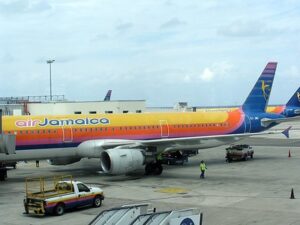
I never got the chance to fly Air Jamaica because of their labor dispute.
What are the chances that Air Jamaica would hold a one-day strike on the first and only day in my 59 years that I tried to fly on the airline? …………..details in “The Trip – Tuesday morning”.
You will not believe what rule #8 is when planning and preparing to participate in a Jamaican holiday parade ………..details in “The Trip – Monday – race day”.

AND THE READERS RESPOND
From time to time interested readers write to me about one thing or another. Many times, I feel that my other readers would be interested, informed, and/or amused by the comments I get. Here is what a Pennsylvania urbanite had to say regarding my computer problems:

“Hi Randy. Three words. GET A MAC!”
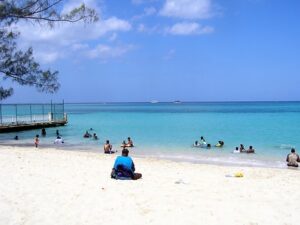
Greetings from Brown’s Town, St. Ann, Jamaica
I woke up this morning in Montego Bay, Jamaica. I went to sleep in Montego Bay as well. This is what transpired today.
PEOPLE/STRATEGY/TRAVEL NEWS
The Objective
One of the objectives I established for myself coming into the 2008 trackchasing season was to see more new tracks in foreign countries. So far, that plan has been working out very well. During just this year, I have now seen tracks in Canada, Thailand, South Africa, Mexico, Jamaica and Georgia. Hey, wait! Georgia’s not a foreign country.
This gives me 14 countries where I have trackchased in my career. I still trail Will White (20) and Roland Vanden Eynde (37) in the contest to see racing in the most countries around the world. However, the next leading trackchaser behind me has seen racing in only seven countries. I have some plans in place to increase my totals even further before the clock strikes twelve in 2008.
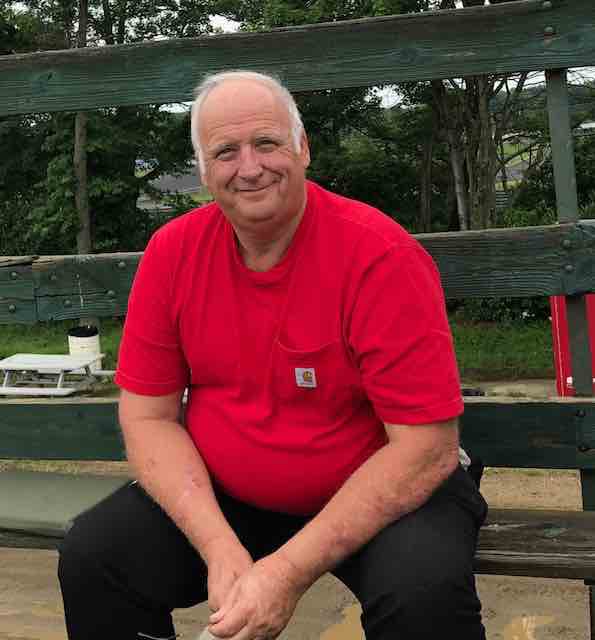
I have to give a shout out to the three trackchasers who have seen racing in Jamaica before I arrived. Paul Weisel made it down to this part of the world as a driver back in 1983. I’ve heard him tell the story of his adventure. That must have been fun.
Will White and Guy Smith visited the same track I saw this week in 1998. That’s pretty impressive considering that by that time I had only seen racing in the United States and Canada. By the way, except for Quebec, I hardly consider Canada a foreign country. It’s more like “Minnesota lite” in the English speaking parts of Canada. That is in no way a knock on Canada, I’m just saying it’s really not much different than the U.S. Let me tell you, the countries I’ve been visiting this year are REALLY different from the U.S. Actually, the more different the better to me. I want to have experiences that are unique to what I am accustomed too and I certainly get that on these trips.
The Trip
Pre-trip
I hardly know where to begin in describing this trip. For lack of a better idea, I’ll start at the beginning. I don’t have too much difficulty getting from point A to point B in the states, especially with the help of my airline sponsorships. However, flying standby is not always the hot ticket (pun intended) when you really want to get somewhere on time.
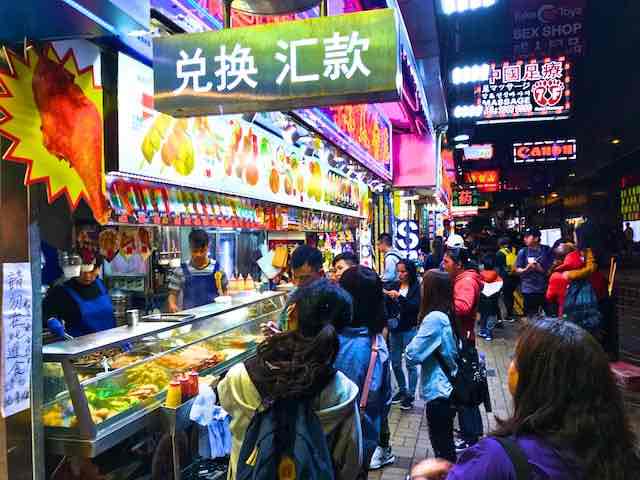
Therefore, I planned my trip to Jamaica the same way I did for my trip to Thailand. When I went to Thailand, I knew I wouldn’t have much difficulty getting to Hong Kong (above). Once in Hong Kong, I purchased a ticket to Bangkok, Thailand.
With this trip, I knew I could get to Atlanta (sooner or later anyway), so I purchased a ticket from Atlanta to Kingston, Jamaica. This gave me a 100% chance of getting to the track in Jamaica on time. However, I am always on the lookout for a better plan.
Sometimes I have to consider an accounting term called “sunk costs”. If you are not familiar with that term let me explain. By the way, I was an accounting major in college until the second half of my freshman year. Then it dawned on me that learning accounting was just too much doggoned work! I did remember the first two rules of accounting though. They are 1) your debits must equal your credits and 2) always keep a sharp pencil. I seem to be better with rule #2.
Anyway, “sunk costs” are expenses you have already paid. You’re never going to get them back no matter what you do in the future. As an example, if you prepaid for a non-refundable movie ticket for tomorrow night and then a friend came up with NCAA men’s basketball championship game tickets (presumably to see UCLA play) for the same night as your movie what would you do? Would you say, “I can’t go to the game, because I already have a movie ticket”? On the other hand, would you say, “the heck with the money I spent on the movies, let’s go watch the Bruins kick-butt”.
If a better idea comes along, I grab it regardless of what my “sunk costs” or previous expenses might be. As they say, “you have to spend money to make money”. People who don’t have much money never seem to really understand what that really means.
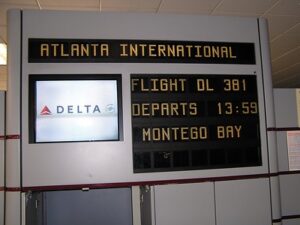
Even though I had a non-refundable ticket taking me from Atlanta to Kingston, Jamaica, I walked away from that ticket. I did this when I discovered I could get a non-stop flight back to Los Angeles from Montego Bay, Jamaica on the ride home. Yes, I would be flying standby on that flight and yes it would cost me some money, but it simplified the return home a good deal. Montego Bay was only half as far from the track as Kingston was, another plus.
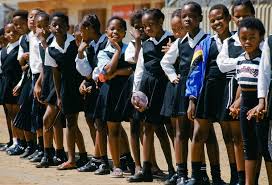
By the way, someone asked me what the five most dangerous, non-warring cities in the world were. I looked it up on line. Johannesburg (above), South Africa topped the list (I was there last month) and Kingston, Jamaica came in fifth. I can’t wait to get to the other three in the top five!
I was still without a working computer. My new computer is beautiful. It has a 17” screen. However, when it’s not working, it’s like carrying around a boat anchor in my briefcase. My cell phone would not be working in Jamaica either. I am paid (in terms of track count) based upon my ability to manage information. I have the best equipment and systems that the “boys back in the shop” can give me. However, when the stuff I have doesn’t work, I relegated to mid-pack with the sick, lame and lazy of my trackchaser brethren.
The race in Jamaica was on Easter Monday. That seemed like at odd date to hold race but I wasn’t complaining. Carol would be gone for the week visiting her parents in New Mexico. That left me to wander about the world anywhere I pleased. Following my trackchasing double in Georgia on Saturday night, my plan was to fly into Montego Bay on Sunday. With one last stop at the Waffle House on Sunday morning, I was bound for “Jamaica mon”. By the way, the Waffle House I visited had a flat-screen TV. What is the world coming too?
Sunday in Jamaica
I was flying standby into Jamaica. The availability looked good but then you never know until they call your name. I was most surprised and pleased to gain a first-class seat for the three-hour flight from Atlanta to Montego Bay. As a matter of fact, I got first-class seating on every plane that offered first class during my entire trip. As our kids used to say regarding themselves when some piece of good fortune came their way, “I’m a lucky duck!”
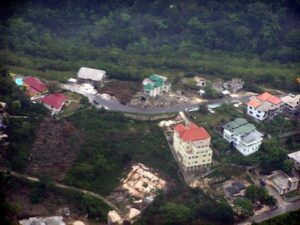
This looked to be an upscale development near Montego Bay.
When I arrived into Montego Bay it was raining lightly. That wasn’t a problem either today or even tomorrow, race day. I would be seeing racing on a road course and that type of racing never rains out. It’s warm and humid in Jamaica all year round. Right now, the daytime temps run into the mid-80s and it doesn’t get much cooler than 72 degrees at night.
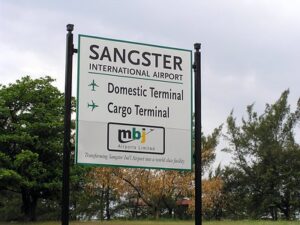
Montego Bay is home to the Sangster International Airport.
I cleared immigration control with ease at the Sangster International Airport. One of the benefits of first-class seating is that you get off the plane first and are automatically ahead of the 150 people who were flying in the “steerage” compartment in the race to clear customs.
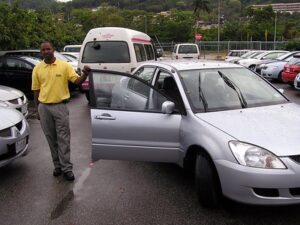
This is Christopher, the Hertz rental car rep. He is now a trackchasing fan!
I had a Hertz rental car reservation. Like much of the world, Jamaica has right side steer cars and they drive on the left side of the road. I was given a 2005 Lancer by Christopher, the local Hertz rep. Please look for Christopher’s picture on my website. I promised him I would include it and I never break a promise.
I had used www.tripadvisor.com to help me discover “Toby’s Resort” in Montego Bay. I had some difficulty making my reservation and I’m going to have to fight with some folks when my credit card bill comes due, but that’s another story for another time.
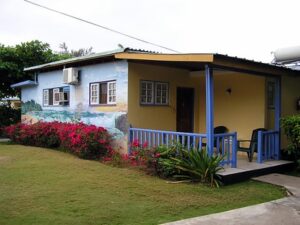
Toby’s had painted their buildings in bright colors.
Toby’s was located at one end of the “Hip Strip” in Montego Bay. The hotel has 65 rooms, a pool, a bar and restaurant. I would only be here for two nights and the $85 per night charge seemed reasonable considering the major resorts were charging well over $300 per night.
When I met the staff, I soon learned that Jamaicans travel to the beat of their own drum and their own timing. Although I had some good service, far too many people seemed totally uninterested in servicing the tourist trade.

By the way, the ethnic diversity in Jamaica in nearly non-existent. I found South Africa and Japan to be the same way. Most residents in these countries look exactly like their countrymen. This is in stark contrast to living in Southern California where the multitude of ethnicities is everywhere.
By the time, I had landed, rented my car, found the hotel, fought over my reservation and went to my room it was 9 p.m. It would have been easy to just call it a night after a long day of travel. However, the RANLAY does not roll that way. I didn’t come all the way to Jamaica (which is just south of Cuba) to sit in my hotel room.
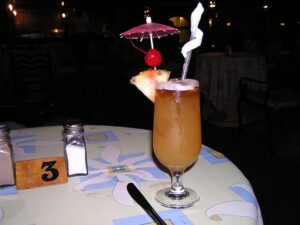
Mai Tai’s rock!
I made my way to the “Hip Strip”. This is a collection of restaurants, souvenir stores and other mainly non-descript retail establishments. Do not in any way mistake this for the Las Vegas strip or Times Square. It’s really not much, but it did have some unique characters for me to encounter along the one-mile walk.
Nearly every cab driver slowed down to inquire if I wanted a taxi. When I told them I would be walking, they came back with “Whadya need, Mon?” “Do you want a smoke…..a girl”? I must have been asked these questions, 50 times during my two-day (actually three-day but more about that later) stay. I don’t smoke and I’ve already got a girl.
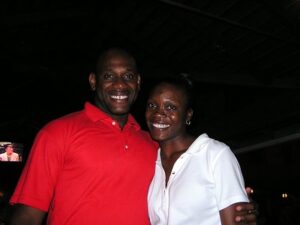
These were my hosts for dinner at the Doctor’s Bay resort.
I came across the Doctor’s Bay Hotel for my late-night dinner. I had the “jerk” pork chops. Nearly every meat in Jamaica can be prepared “jerk” style. This simply means the meat is prepared in a spicy, somewhat like BBQ sauce, mixture. I love spicy food and this was delicious. I also had one of the best Mai Tai’s I’ve ever had from some excellent servers (above).
My walk back to the hotel included my fair share of “Hey boss, what ya need?” questions. Toby’s, my hotel maintains 24-hour security much like all the other Jamaican properties I visited. South Africa does things the same way. I guess if you are a “top five” most dangerous country in the world winner you need to do that.
I spent a few minutes conversing with two Jamaican security guards about the topics of the day. They warned me to be careful when I walked about. I never really felt in danger at any time, but I tried to keep a watchful eye out to avoid any kind of trouble.
Monday – Race day
The official language of Jamaica in English. Although when Jamaicans talk amongst themselves, it’s impossible to decipher their conversations. Carol and I visited Jamaica several years ago during a Caribbean cruise. From the hip strip, I could see two cruise ships that were in Montego Bay’s port.
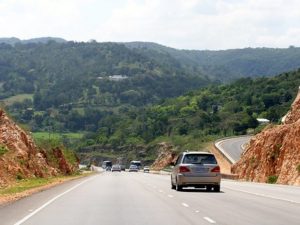
The Jamaican topography is one of rolling, heavily forested hills (jungle?). The highways were good, but the local roads were not. They were filled with potholes. The highest point in Jamaica is the peak of the Blue Mountains at 7,402 feet. It is in this area that the famous Blue Mountain Jamaican coffee is produced. I brought some back for Carol who is an avid coffee drinker, although I never touch the stuff.
Let me say that Jamaican highway drivers are the worst. They make the drivers in Mexico seem like straight-A students in a driver’s ed class. Jamaican drivers will pass you regardless of how much oncoming traffic is headed their way. Most roads are two-lane affairs. Jamaican drivers will make a pass and the car being passed is expected to move over toward the shoulder of the road. The oncoming driver is expected to move over to the shoulder of the road on his side. This leaves one lane up the middle of the two-lane highway for the passing driver. It is absolutely crazy!
I saw highway police with people pulled over nearly every five miles. The police wore bullet proof vests on the outside of their uniforms. I also saw several accident victims and my share of speeding emergency vehicles. Normally, I don’t notice this kind of thing when I travel, but it was impossible to ignore in Jamaica.
During my travels, I came across some local Jamaican newspapers. There were two items of special note. First, they commonly place photos in the paper showing mourners viewing the casket of their loved one. I’ve never seen that anywhere else before.
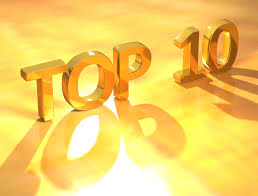
I also came across a top 10 list of how to survive a road march (parade) during the holiday festival season. I found rule #8 to be most interesting. Here are the top 10
Rule #1 – Keep hydrated….
Rule #2 – Dress in cool clothing….
Rule #3 – Wear a hat and sunglasses….
Rule #4 – Wear comfortable shoes….
Rule #5 – Eat a good meal before you start….
Rule #6 – Drink energy drinks….
Rule #7 – Use Sun block
Rule #8 – Do not allow any of the other drunk, tipsy, high or over-exuberant revelers to engage in illicit sex acts with you on the road, it’s bad for your health
Rule #9 – Stay in the shade as much as possible
Rule #10 – Make sure you are well-rested the night before.
Unfortunately, I did not come across any Jamaican parades!
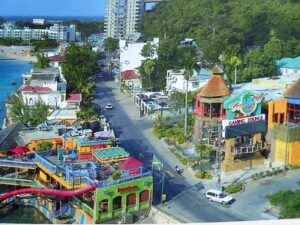
This is a commercial picture of the “Hip Strip”. My hotel, the Toby’s Resort, is located at the far end of the strip.
I spent Monday morning and Monday afternoon at the races. When I got back to my hotel, I had another walk down the “Hip Strip”, had dinner and went back to the room to pack for my departure tomorrow. I had just two days in Jamaica, but with a car, I was able to see and do a lot. Outside of the major resorts, the country shows its poverty. I was glad to view the Jamaican culture up close. I can see how it would be easy to go to some large and exclusive resort, hang out at the hotel beach each day, eat at the hotel restaurant each night, and never really “see” Jamaica. I don’t like to travel like that, but I can understand why some people might see that as the preferred option.
Tuesday morning – departure day
My plane didn’t leave today until 4:25 p.m. How lucky was I to be able to get a non-stop flight from Montego Bay to Los Angeles. The flight only operates four days per week and Tuesday was not one of those days. I figured they had added an extra day for this flight because it was Easter.
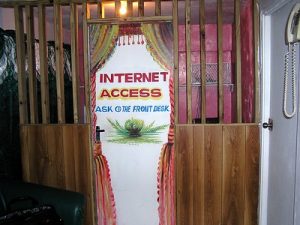
After a quick breakfast on the “Hip Strip,” I found a place to get on the internet. By the way, I never did find an ATM to get any Jamaican dollars while I was here. Jamaicans take U.S. dollars, but I’m sure I took it in the shorts every time I was at the mercy of a local’s exchange rate policy.
Filling my rental car’s tank before I returned the car to Hertz was a challenge. I stopped at a local Texaco station right next to the Sangster International Airport. It was not immediately obvious that only certain pumps were for cash transactions and others for credit card usage. Of course, I got in the wrong line.
I had picked up the car with the tank 5/8 full. Therefore I had to return it with that amount of gasoline in the tank. It’s an algebraic challenge to figure out how much gas is needed when gas is being sold in liters, the miles I had traveled were being measured in kilometers. I simply solved for “X” and determined I needed 16 liters. I told the full-service attendant that’s what I needed. “No problem, mon,” as he stuck the gas nozzle in my tank and went off to serve another customer.
I was lucky I kept an eye on things. When the gas pump showed I was rapidly approaching 16 liters the gas attendant was showing no interest in the situation at all. I had to stop the gas flow at the point where I reached my 16 liters. Then I had to move the car and hassle with paying by credit card inside the station’s office. Fortunately, when I got back to the car and started the engine the gas gauge moved right up to 5/8 and stopped. I’ve always been pretty good with numbers.
When I returned to the Hertz rental car parking lot, I encountered “Christopher” again. He had been on my website and now was a big fan. He had just one question, “What’s up with those Dreaded East Coast Trackchasers?” I didn’t have the heart to fill him in.
Tuesday afternoon – departure day
When I went to the Air Jamaica ticket counter to check-in I inquired about the load factor on my flight today. All indications told me the load was light. It was. There were only 25 passengers booked! I was concerned they might not make the trip all the way from Montego Bay to Los Angeles with such a light load. I was right but for the wrong reasons.
I went into the terminal to wait for my flight. The international terminal is beautiful and modern in Montego Bay. While I waited I had one of the best cheeseburgers I’ve ever had at Jimmy Buffet’s Margaritaville restaurant.

It was then that I noticed a problem. The first three Air Jamaica flights of the day had been canceled. The next three were all delayed. What was happening? I would soon learn that the Air Jamaica flight attendants were staging a one-day strike. I have been alive for 59 years and for some reason, the first and only day that I have ever planned to fly on Air Jamaica Airlines, they decide to go on a one-day strike. Yes, this may have been my worst ever logistical trackchasing trip in my life.
The long and the short of it was I would not be leaving Montego Bay today. I would not return to Los Angeles on Tuesday. The best I could do was to get back at home by Wednesday. However, I had a plan to return to the southeast on Friday. It might not even make sense to go back to L.A. at all. Since Carol wasn’t home, I might just stay on this side of the world for the rest of the week.
It was 5 p.m. and I had no flight, I had no rental car, I had no hotel, I had no computer internet connection and I had no cell phone. Ya, I guess this is how the trackchasers of yesteryear had to do it, although they rarely went very far from home in the old days.
I sat down to plan my attack. I decided to rent a cell phone. They were only seven dollars for the day and 30 minutes of international call time was only 11 dollars. That sure beat the pay phone I considered using until the operator told me the first minute to the U.S. would be $25 and each additional minute three dollars.
The woman who rented me the phone recommended a hotel that would give me a room for $46. She also personally selected a cab driver to take me there for another ten dollars U.S. This woman was most helpful as my original travel plan was falling apart.
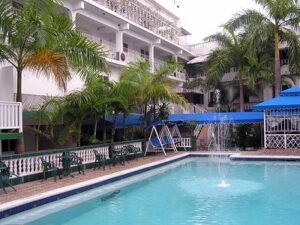
Actually, the hotel reminded me of some of the garden hotels in the French Quarter of New Orleans.
Soon I was arriving at the Hotel Glorianna. If you think of a somewhat run-down New Orleans garden hotel you might be close. The hotel also had rooms for $66 and $86, but it was just me, I could go the budget route like I’m used to doing.
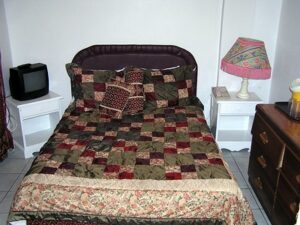
When Air Jamaica went on a one-day strike I had to get a brand new hotel room. It wasn’t very big.
My room was about 8’ by 10’. It was small and had exposed light bulbs. Of course, you can see the room and everything I’ve talked about at www.randylewis.org but then if you are reading this I guess you’re already there.
The room was also next door to the swimming pool and the bar. Of course, the bar played loud and continuous Reggae music until nearly midnight. I would like to kill the guy who kept asking for “Hot, Hot, Hot”.
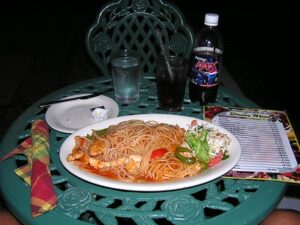
I did get a good meal of spaghetti and chicken at the hotel’s restaurant.
Nevertheless, I had my dinner poolside (spaghetti and chicken) and smiled at my good fortune. I was in Jamaica. I was having dinner poolside while listening to Reggae music. I had seen racing at a new track in a new country. I couldn’t wait to tell you about it.
Wednesday morning – departure day again!
It was still a major bummer not having a working computer. I probably spent $25-30 on internet usage fees along the way up to this point. I am increasingly finding that computers are much more important for information gathering than email receipts. I didn’t use to think that.
I also found that the three most important items for information gathering that I had with me on this trip were my cell phone, my reading glasses and my airline schedule guide. Yes, my lifestyle is different than most.
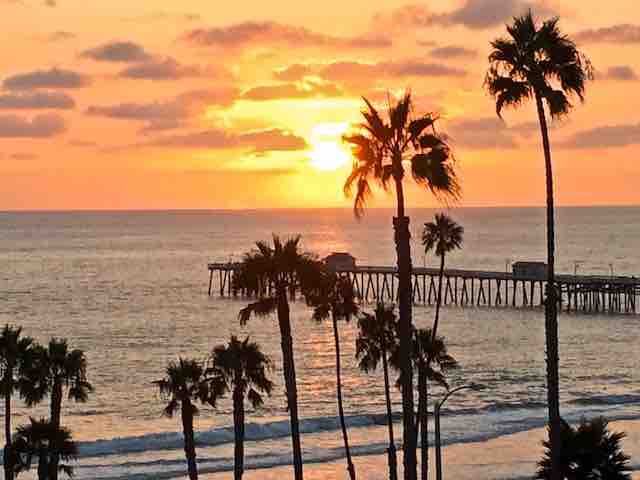
I will continue to take more trips like this. Some folks ask why I would ever want to leave the paradise-like area of San Clemente. I figure San Clemente will always be there (even though we live in an earthquake zone!). When I’m old and don’t feel like traveling I can always walk at the beach. However, now I’m just a kid and the world is my oyster!
Today, I didn’t wait for Air Jamaica again. I hopped a Delta flight to Atlanta. I would stay there for two days and begin my next trackchasing trip on Friday. Heck, I was in first class on the way back to the states. I had nothing to complain about.
I did buy a beautiful bottle of Jamaican rum for my friend in Atlanta. Then, IN A TRAVELING FIRST, the TSA folks ran us through a full airport security check on THE WAY OUT of the Atlanta airport. What? Why? I’ve had that happen when I’ve landed back in the U.S. from some foreign destination and am transferring to a domestic flight but never when the U.S. arriving point is your final stop.

I inquired, in a nice way, that wouldn’t get me thrown in jail, what was up. I was told that arriving U.S. passengers would be walking through the secured part of the airport after they cleared U.S. customs and before they could hit the street. Therefore, it was off with the shoes, take the laptop out, take your gels and liquids out before we could do anything. Apparently, Atlanta is one of only two U.S. airports with this policy. This also meant the loss of the rum. Sorry, Dale, this had to happen if the trip is going to be classified as one of the worst ever logistical trips!
The People
I met a number of nice people at the track today. I’m not sure I got everyone’s name or if I did if I got it right. Please accept my apologies if I made a mistake here.
I had a wonderful trackchasing interview with the track announcer, Chris. He was most interested in the hobby of trackchasing. With the robust sound system at the track, I expect that 5,000 or more Jamaicans went back home and fired up their computers to do a Google search for the word “trackchaser”. If they did, they found the website for the World’s #1 Ranked Trackchaser at the top of the Google search list. That trackchaser had just made his first-ever trackchasing visit to Jamaica.
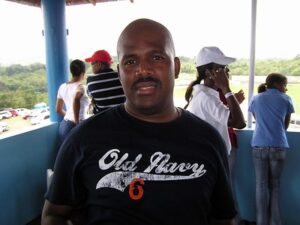
I also met a photographer, pictured on my website, who works for a Jamaican racing magazine. They did the good-looking race program that sold for 200 Jamaican dollars (about $3 U.S.) today. I even took HIS photo for my website.
Hilary Jardine was next on the list of Jamaican dignitaries for me to meet. Mr. Jardine is president of the Jamaican Race Driver’s Club. He has been involved with Jamaican racing for more than 50 years and was one of the founders of the Dover Raceway. Mr. Jardine had given me some help in advance of the race and was most gracious today. Thank you, Hilary!
My final introduction was to Mr. Mike Henry. He was introduced to me as a “minister” of Jamaica. He wasn’t part of the clergy, but he is Minister of Transportation for the country. He was at the track today to announce that the government would be providing one million dollars (don’t know if that was in Jamaican or U.S. currency) for the construction of a bridge so fans could get to the track easier.

Mr. Henry was the highest-ranking political official I have ever met while trackchasing. I don’t count my encounter with Richard Nixon at the Illinois State Fair in this ranking for two reasons. I was at the fair as a “racechaser” and not a “trackchaser” for the USAC Silver Crown races on the one-mile dirt oval. I only got to shake his hand and did not really meet the sitting president. At least Carol was able to see my aggressive posture that enabled me to get beside President Nixon’s open convertible (something the Secret Service apparently overlooked). She could then project my behavior into 36 years of future support and comfort. Anyway, that’s the way I like to tell the story.
Mr. Henry, upon learning of my world ranking in trackchasing asked, “Is this your favorite all-time track?” Proving that I could provide a political answer back to a politician, I told him, “This is a beautiful track. With the money you’re providing for the bridge, it’s going to be even better. I’m looking forward to a wonderful day of racing”.
The people I met at the Dover Raceway were great. I hope more trackchasers decide to take in an event down here.
PROVINCE RANKINGS
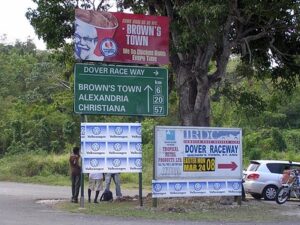
St. Ann
Today was my first ever visit to Jamaica for trackchasing. This is my 14thtrackchasing country. As it turns out, just a few trackchasers have ever ventured down here. None of them has seen more than one track in Jamaica. Why? Jamaica currently has only one countable track. I hope that my international visits and those of the others in what is becoming the “big three” (Roland Vanden Eynde and Will White) will encourage trackchasers from all over the world to branch out a bit.
By the way, I make up the smallest angle of trackchasing’s “big three” triangle. Trackchasers Roland Vanden Eynde (Belgium) and Will White (United States) have blazed the trails for all other trackchasers on the foreign travel front. It never hurts to get out of one’s comfort zone from time to time.
TRACK TYPE
In the world of trackchasing, we have three types of track configurations that are considered countable. These include ovals, circuits (road courses) and figure 8 tracks. Generally, a road course includes both left and right turns. Figure 8 tracks cross over themselves.
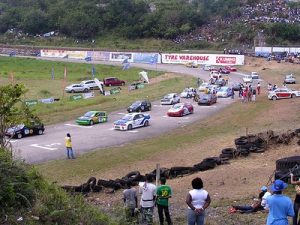
The cars are on the grid.
This afternoon I saw racing on an asphalt road course. This was my 133rd-lifetime circuit track (world ranking #3). Roland Vanden Eynde leads the world in circuit visits with 351.
RACE REVIEW
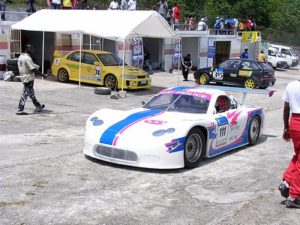
This was one of the very best looking cars at the track today.
DOVER RACEWAY, BROWN’S TOWN, ST. ANN, JAMAICA
I had an absolutely wonderful day of trackchasing. Normally, I’m not much of a fan of circuit racing but today just seemed a little bit different than the normal road racing experience. Let me tell you why I felt that way.
Getting to the track was a challenge. It’s located well off the main A1 highway and the ocean up in the hills of Jamaica. The roads aren’t very good the closer one gets to the track.
Once I got somewhere near the track people started parking on each side of the already narrow and pothole-filled two-lane highway (ala Eldora). I gave that some thought but had no idea how much further I still had to go to reach the track’s property. When I did reach the parking area, I found the grassy and somewhat moist ground was filled with cars. I sort of made my own spot and readied for a fun international trackchasing adventure.

$1,500 for a pit pass!!! I’ve never paid that much before.
Regular tickets for today’s race sold for 1,000 Jamaican dollars. Pit passes were $1,500. I wanted a pit pass but somehow that got lost in the translation and I was given a wristband that was only good for general admission. I didn’t know of this oversight until I was on the other side of the track’s property and was denied admission to the paddock (pit) area.
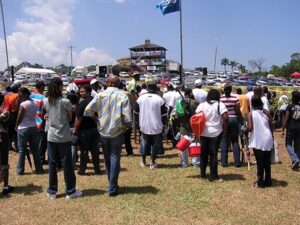
The crowd had to wait for the practice to stop so they could cross the track.
Once I cleared the ticket booth, I waited with my fellow fans to cross the track. Practice was going on and the crowd swelled to more than 500 people waiting to cross into the infield. The V.I.P. tower sits on the highest point of the track’s grounds. It’s sort of a “pagoda” style affair. From its peak, it provides a fantastic view of the track.
I arrived at the scheduled start time of 11:30 a.m. For some unknown reason, the program’s start of racing was delayed almost two hours. Maybe they get that from their American cousins. It was no big deal to me. This gave me time to explore the place.
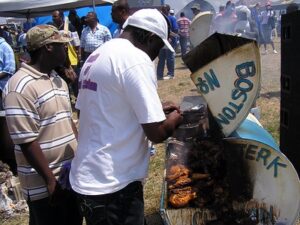
It was time for more food. I bought my jerk chicken from this vendor.
Probably the most impressive part of my tour was a large area where food vendors were cooking up “jerk” chicken by the hundreds. The chicken was being cooked in large 55-gallon steel drums that had been cut in half horizontally for the task. Jamaican reggae music was blaring over the robust sound system. It was a real carnival atmosphere and the air was heavy with the scent of BBQ chicken. Please don’t miss my photos link in this report for photos of the jerk chicken cooking as well as everything I’ve mentioned in this report.
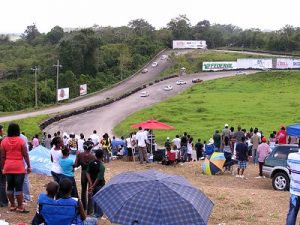
This was a great track for good sight lines.
The track itself had significant elevation changes. For the fan that was willing to walk around, nearly every inch of the nearly 2-mile course was visible. As I toured the track grounds I was most impressed by the quantities of people sitting on the hillsides. I did not see any formal seating areas. Folks just found a place to sit and did so.
I was told by one track official that there were more than 5,000 people here today. He said they expect more than 8,000 for the upcoming Caribbean championship meet in May. The fans were also very enthusiastic. When the first race went off they stood, cheered, yelled and waved their arms in excitement. I rarely, if ever, see this level of fan support in the U.S. with the exception of major NASCAR stock car races.
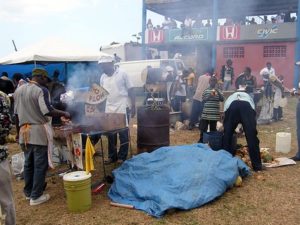
More food!
My next stop took me into the paddock area. There was even more food available in the paddock. Before I could enter I did need to go back to the ticket booth to get a wrist band for the paddock area. I thought I had done that when I made my original ticket purchase but I was told I had not. I was paying in U.S. dollars and getting change in Jamaican. I’m not really sure how much the pit pass cost me, but I think it was around $25 U.S.
The paddock area was unique as well. Each car had its own private garage. Fans were allowed to get up close and personal with the cars and drivers. Race teams had a steel barred gate to keep spectators at bay if they needed too.
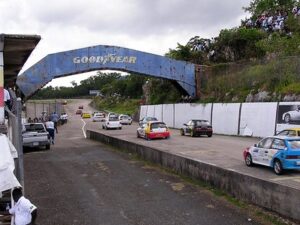
You’re looking at the start of this race.
I made several visits to the paddock area, which was also teeming with fans. The start/finish area and a beautiful old “Goodyear” bridge spanned the track at this point. If you come to the Dover Raceway make sure you can gain admission to the paddock area.
Today’s program called for ten races amongst five classes. The races were short just 5-7 laps. The classes included: Improved Production, Modified Production – class 3, Modified Production – classes 1 and 2, IP 45 and C&W Broadband Thundersport. This didn’t mean anymore to me than I suspect it means to you. Some races had as many as 20 cars or so and some as few as 6-7 cars.
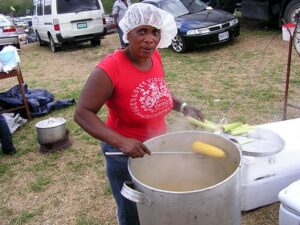
How about some corn on the cob?
I roamed around the track taking pictures at virtually every vantage point there was to see. In between taking pictures and visiting the paddock area, I stopped to have some Jamaican food. I dined on “jerk” chicken, Jamaican citrus punch, Heineken beer and corn on the cob. It was all great.
After I had been at the track for some four hours, my afternoon was wrapping up. Some folks were starting to leave. I feared it might be a nightmare, possibly even in the dark, getting more than 5,000 people down a winding pothole-filled two-lane road. The road wasn’t even two-lanes wide with the spectator cars parked on the shoulder.
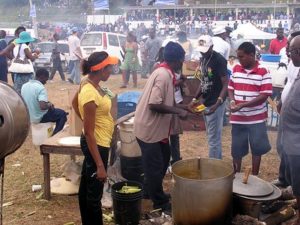
I had to eat just one more thing.
This proved to be a wise decision on my part. Even though it was 4 p.m. there were still a few stragglers driving UP the road to get to the track. There was not enough room on the road for one car to drive down the road and one to drive up the road at the same time. This meant that cars had to squeeze over to the side and stop to allow a car coming in the opposite direction to pass. It was during this time that I wished I had purchased the “collision damage waiver” insurance from Hertz!
RENTAL CAR UPDATE
Montego Bay, Jamaica – Sunday/Tuesday
Jamaicans drive right side steer cars and drive on the left side of the road. I’ve traveled enough under these conditions that I’m not bothered by this at all. I try to keep one mantra in mind when making turns. “Lefts are easy, rights are scary”. Today I had would be driving the Hertz Rental Car Racing 2005 Lancer.
I drove the Hertz Rental Car Racing Lancer 114 miles in slightly more than two days that I had it. I have never driven in a country with more wild and crazy drivers. I paid an average price of about $3.76 per gallon. The Lancer gave me about 28.8 miles per gallon in fuel mileage at a cost of 13.1 cents (U.S.) per mile. The car cost 94.7 cents per mile to rent, all taxes included.
Thanks for reading about my trackchasing,

Randy Lewis
Jamaica’s #1 Trackchaser ….along with some others
The truth seldom brings complaint.
TRAVEL DETAILS
AIRPLANE
Los Angeles, CA – Atlanta, GA – 2,113 miles
RENTAL CAR
Hartsfield Atlanta International Airport – trip begins
Hartwell, Georgia – 145 miles
Lavonia, Georgia – 161 miles
Hartsfield Atlanta International Airport – 278 miles
AIRPLANE
Atlanta, Georgia – Montego Bay, Jamaica – 1,118 miles
RENTAL CAR
Sangster International Airport – trip begins
Brown’s Town, St. Ann, Jamaica – 46 miles
Sangster International Airport – 114 miles
TRACK ADMISSION PRICES:
Hartwell Motor Speedway – Free
Lavonia Motor Speedway – Free
Dover Raceway – About $25
RANKINGS
LIFETIME TRACKCHASER STANDINGS UPDATE:
There are no trackchasers currently within 100 tracks of my lifetime total. It’s not my fault!
- Randy Lewis, San Clemente, California – 1,322
Other notables
These worldwide trackchasers are within 10 tracks (plus or minus or more) of Carol’s current trackchaser total.
- Kevin Eckert, Indianapolis, Indiana – 450
- Carol Lewis, San Clemente, California – 358
- Ken Schrader, Concord, North Carolina – 354
- Max Allender, Des Moines, Iowa – 349
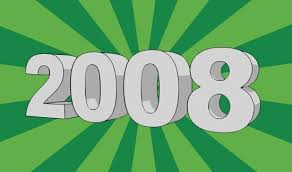
2008 TRACKCHASER STANDINGS
- Randy Lewis, San Clemente, California – 24
- Mike Knappenberger, Reading, Pennsylvania – 16
- Ed Esser, Madison, Wisconsin – 12
- Carol Lewis, San Clemente, California – 9
- Guy Smith, Effort, Pennsylvania – 9
Tracks have been reported by 24 different worldwide trackchasers this season.
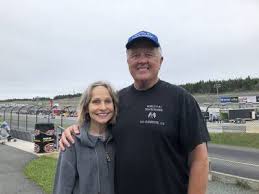
LIFETIME COUPLES TRACKCHASING STANDINGS
- Randy & Carol Lewis, San Clemente, California – 1,680
- Allan & Nancy Brown, Comstock Park, Michigan – 1,672
- Guy & Pam Smith, Effort, Pennsylvania – 1,666
LIFETIME NATIONAL GEOGRAPHIC DIVERSITY STANDINGS
2007 NGD results are posted at www.randylewis.org
UPCOMING TRACKCHASING PLANS
I honestly wanted to go home after this race, but the people of Jamaica wouldn’t let me. More on that next time. I’ll just hang around and see what I can pick up. I’ll get back to San Clemente someday.
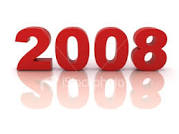
RACETRACKS VISITED IN 2008
(** not the first time to visit this track)
1,299. Barnes Lake Ice Track, Ashcroft (road course), British Columbia, Canada – January 13
1,300. Bira Circuit, Pattaya (road course), Thailand – January 19
1,301. Cameron Lake Ice Track (oval), Erskine, Minnesota – January 26
1,302. Birch Lake Ice Track (oval), Hackensack, Minnesota – January 27
1,303. Mille Lacs Lake Ice Track (road course), Garrison, Minnesota – January 27
1,304. Mille Lacs Lake Ice Track (oval), Garrison, Minnesota – January 27
1,305. Ozark Empire Fairgrounds (oval), Springfield, Missouri – February 1
1,306. Atlanta Motor Speedway (road course), Hampton, Georgia – February 2
1,307. Brainerd International Raceway Ice Track (road course), Brainerd, Minnesota – February 3
1,308. Bay of Green Bay Ice Track (road course), Marinette, Wisconsin – February 9
1,309. Lake Speed Ice Track (oval), Tilleda, Wisconsin – February 9
1,310. Shawano Lake Ice Track – North Shore (oval), Shawano, Wisconsin – February 10
1,311. Cecil Bay Iceway (oval) – Cecil, Wisconsin – February 10
1,312. Mototown USA (oval) – Windsor, Connecticut – February 15
1,313. Moosehead Lake Ice Track (oval) – Greenville Junction, Maine – February 16
1,314. Clarence Creek Ice Track (oval) – Clarence Creek, Ontario, Canada – February 17
1,315. Durban Grand Prix (road course), KwaZulu-Natal, South Africa – February 24
1,316. Lake La Biche Ice Track (road course), Lake La Biche, Alberta, Canada – March 1
1,317. Rice Lake Ice Track (oval), Rice Lake, Wisconsin – March 8
1,318. Ashland Ice Track (oval), Ashland, Wisconsin – March 9
1,319. Autodromo Hermanos Rodriquez (road course), Mexico City, Mexico – March 16
1,320. Hartwell Motor Speedway (oval), Hartwell, Georgia – March 22
1,321. Lavonia Speedway, Lavonia (oval), Georgia – March 22
1,322. Dover Raceway (road course), Brown’s Town, St. Ann, Jamaica – March 24
LIKE TO KNOW MORE ABOUT JAMAICA – TRACKCHASING COUNTRY #14?

Jamaica – FAST FACTS*
Provided by my friends at Wikipedia and others.
Jamaica is an island country situated in the Caribbean Sea. Spanning 10,990 square kilometres (4,240 sq mi) in area, it is the third-largest island of the Greater Antilles and the Caribbean(after Cuba and Hispaniola). Jamaica lies about 145 kilometres (90 mi) south of Cuba, and 191 kilometres (119 mi) west of Hispaniola (the island containing the countries of Haiti and the Dominican Republic); the British Overseas Territory of the Cayman Islands lies some 215 kilometres (134 mi) to the north-west.
Originally inhabited by the indigenous Arawak and Taíno peoples, the island came under Spanish rule following the arrival of Christopher Columbus in 1494. Many of the indigenous people were either killed or died of diseases to which they had no immunity, and the Spanish thus forcibly transplanted large numbers of African slaves to Jamaica as labourers. The island remained a possession of Spain until 1655, when England (later Great Britain) conquered it, renaming it Jamaica. Under British colonial rule Jamaica became a leading sugar exporter, with a plantation economy dependent on the African slaves and later their descendants. The British fully emancipated all slaves in 1838, and many freedmen chose to have subsistence farms rather than to work on plantations. Beginning in the 1840s, the British began utilizing Chinese and Indian indentured labour to work on plantations. The island achieved independence from the United Kingdom on 6 August 1962.
With 2.9 million people, Jamaica is the third-most populous Anglophone country in the Americas (after the United States and Canada), and the fourth-most populous country in the Caribbean. Kingston is the country’s capital and largest city. The majority of Jamaicans are of African ancestry, with significant European, Chinese, Indian, Lebanese, and mixed-race minorities. Due to a high rate of emigration for work since the 1960s, there is a large Jamaican diaspora, particularly in Canada, the United Kingdom, and the United States. The country has a global influence that belies its small size; it was the birthplace of the Rastafari religion, reggae music (and associated genres such as dub, ska and dancehall), and it is internationally prominent in sports, most notably cricket, sprinting and athletics.
Jamaica is an upper-middle-income country with an economy heavily dependent on tourism; it has an average of 4.3 million tourists a year. Politically it is a Commonwealth realm, with Elizabeth II as its queen. Her appointed representative in the country is the Governor-General of Jamaica, an office held by Patrick Allen since 2009. Andrew Holness has served as Prime Minister of Jamaica since March 2016. Jamaica is a parliamentary constitutional monarchy with legislative power vested in the bicameral Parliament of Jamaica, consisting of an appointed Senate and a directly elected House of Representatives.
History
Prehistory
Humans have inhabited Jamaica from as early as 4000–1000 BC. Little is known of these early peoples. Another group, known as the “Redware people” after their pottery, arrived circa 600 AD, followed by the Arawak–Taíno circa 800 AD, who most likely came from South America.
Though often thought to have become extinct following contact with Europeans, the Taíno in fact still inhabited Jamaica when the English took control of the island in 1655. Some fled into interior regions, merging with African Maroon communities.Today, only a tiny number of Jamaican natives, known as Yamaye, remain. The Jamaican National Heritage Trust is attempting to locate and document any remaining evidence of the Taíno.
Spanish rule (1509–1655)
Christopher Columbus was the first European to see Jamaica, claiming the island for Spain after landing there in 1494 on his second voyage to the Americas. He later returned in 1503; however, he was shipwrecked and he and his crew were forced to live on Jamaica for a year whilst waiting to be rescued. Meanwhile, the Taínos began dying in large numbers, either from introduced diseases to which they had no immunity, or from enslavement by the Spanish. As a result, the Spanish began importing slaves from Africa to the island. Many slaves managed to escape, forming autonomous communities in remote and easily defended areas in the interior of Jamaica, mixing with the remaining Taino; these communities became known as Maroons. Small numbers of Jews also came to live on the island. By the early 17th century it is estimated that no more than 2,500-3,000 people lived on Jamaica.
Early British period
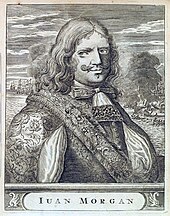
Henry Morgan was a famous Caribbean pirate and privateer; he had first come to the West Indies as an indentured servant, like most of the early English colonists.
The English began taking an interest in the island and, following a failed attempt to conquer Santo Domingo on Hispaniola, Sir William Penn and General Robert Venables led an invasion of Jamaica in 1655. When the English captured Jamaica, the Spanish colonists fled after freeing their slaves. Many slaves dispersed into the mountains, joining the already established maroon communities. During the centuries of slavery, Maroons established free communities in the mountainous interior of Jamaica, where they maintained their freedom and independence for generations. Meanwhile, the Spanish made several attempts to re-capture the island, prompting the British to support pirates attacking Spanish ships in the Caribbean; as a result piracy became rampant on Jamaica, with the city of Port Royal becoming notorious for its lawlessness. Spain later recognized English possession of the island with the Treaty of Madrid (1670). As a result, the English authorities sought to reign in the worst excesses of the pirates.
In 1660, the population of Jamaica was about 4,500 white and 1,500 black. By the early 1670s, as the English developed sugar cane plantations worked by large numbers of slaves, black Africans formed a majority of the population. The Irish in Jamaica also formed a large part of the island’s early population, making up two-thirds of the white population on the island in the late 17th century, twice that of the English population. They were brought in as indentured labourers and soldiers after the conquest of 1655. The majority of Irish were transported by force as political prisoners of war from Ireland as a result of the ongoing Wars of the Three Kingdoms. Migration of large numbers of Irish to the island continued into the 18th century.
A limited form of local government was introduced with the creation of the House of Assembly of Jamaica in 1664; however, it represented only a tiny number of rich plantation owners. In 1692, the colony was rocked by an earthquake that resulted in several thousand deaths and the almost complete destruction of Port Royal.
18th-19th centuries
During the 1700s the economy boomed, based largely on sugar and other crops such as coffee, cotton and indigo. All these crops were worked by black slaves, who lived short and often brutal lives with no rights, being the property of a small planter-class. A large slave rebellion, known as Tacky’s War, broke out in 1760 but was defeated by the British.
By the beginning of the 19th century, Jamaica’s dependence on slave labour and a plantation economy had resulted in black people outnumbering white people by a ratio of almost 20 to 1. Although the British had outlawed the importation of slaves, some were still smuggled in from Spanish colonies. While planning the abolition of slavery, the British Parliament passed laws to improve conditions for slaves. They banned the use of whips in the field and flogging of women; informed planters that slaves were to be allowed religious instruction, and required a free day during each week when slaves could sell their produce, prohibiting Sunday markets to enable slaves to attend church.
The British abolished the slave trade in 1807, but not the institution itself. In 1831 a huge slave rebellion, known as Baptist War, broke out, led by the Baptist preacher Samuel Sharpe. The rebellion resulted in hundreds of deaths, the destruction of many plantations, and resulted in ferocious reprisals by the plantocracy class. As a result of rebellions such as these, as well as the efforts of abolitionists, the British outlawed slavery in its empire in 1834, with full emancipation from chattel slavery declared in 1838. The population in 1834 was 371,070, of whom 15,000 were white, 5,000 free black; 40,000 ‘coloured’ or free people of color (mixed-race); and 311,070 were slaves. The resulting labour shortage prompted the British to begin to “import” indentured servants to supplement the labour pool, as many freedmen resisted working on the plantations. Workers recruited from India began arriving in 1845, Chinese workers in 1854. Many South Asian and Chinese descendants continue to reside in Jamaica today.
Over the next 20 years, several epidemics of cholera, scarlet fever, and smallpox hit the island, killing almost 60,000 people (about 10 per day). Nevertheless, in 1871 the census recorded a population of 506,154 people, 246,573 of which were males, and 259,581 females. Their races were recorded as 13,101 white, 100,346 coloured (mixed black and white), and 392,707 black.
Early 20th century

Marcus Garvey, father of the Back to Africa Movement and Jamaica’s first National Hero
In 1907 Jamaica was struck by an earthquake – this, and the subsequent fire, caused immense destruction in Kingston and the deaths of 800-1,000 people.
Unemployment and poverty remained a problem for many Jamaicans. Various movements seeking political change arose as a result, most notably the Universal Negro Improvement Association and African Communities Leaguefounded by Marcus Garvey in 1917. As well as seeking greater political rights and an improvement for the condition of workers, Garvey was also a prominent Pan-Africanist and proponent of the Back-to-Africa movement. He was also one of the chief inspirations behind Rastafari, a religion founded in Jamaica in the 1930s that combined Christianity with an Afrocentric theology focused on the figure of Haile Selassie, Emperor of Ethiopia. Despite occasional persecution, Rastafari grew to become an established faith on the island, later spreading abroad.
The Great Depression of the 1930s hit Jamaica hard. As part of the British West Indian labour unrest of 1934–39, Jamaica saw numerous strikes, culminating in a strike in 1938 that turned into a full-blown riot. As a result, the British government instituted a commission to look into the causes of the disturbances; their report recommended political and economic reforms in Britain’s Caribbean colonies.
Jamaica slowly gained increasing autonomy from the United Kingdom. In 1958 it became a province in the Federation of the West Indies, a federation of several of Britain’s Caribbean colonies. After leaving the Federation, Jamaica attained full independence on 6 August 1962. Bustamante, at the age of 78, became the country’s first prime minister.
Post-independence era
Strong economic growth, averaging approximately 6% per annum, marked the first ten years of independence under conservative JLP governments; these were led by successive Prime Ministers Alexander Bustamante, Donald Sangster (who died of natural causes within two months of taking office) and Hugh Shearer. The growth was fuelled by high levels of private investment in bauxite/alumina, tourism, the manufacturing industry and, to a lesser extent, the agricultural sector. In terms of foreign policy Jamaica became a member of the Non-Aligned Movement, seeking to retain strong ties with Britain and the United States whilst also developing links with Communist states such as Cuba.
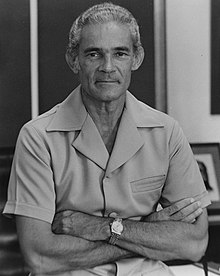
Michael Manley, Prime Minister 1972-80 and 1989-92
The optimism of the first decade was accompanied by a growing sense of inequality among many Afro-Jamaicans and a concern that the benefits of growth were not being shared by the urban poor, many of whom ended up living in crime-ridden shanty towns in Kingston. This, combined with the effects of a slowdown in the global economy in 1970, led to the voters electing the PNP under Michael Manley in 1972. Manley’s government enacted various social reforms, such as a higher minimum wage, land reform, legislation for women’s equality, greater housing construction and an increase in educational provision. Internationally he improved ties with the Communist bloc and vigorously opposed the apartheid regime in South Africa. However, the economy faltered in this period due to a combination of internal and external factors (such as the oil shocks). The rivalry between the JLP and PNP became intense, and political and gang-related violence grew significantly in this period.
Independence, however widely celebrated in Jamaica, has been questioned in the early 21st century. In 2011, a survey showed that approximately 60% of Jamaicans believe that the country would have been better off had it remained a British colony, with only 17% believing it would have been worse off, citing as problems years of social and fiscal mismanagement in the country.
Government and politics
Jamaica is a parliamentary democracy and constitutional monarchy. The head of state is the Queen of Jamaica (currently Elizabeth II), represented locally by the Governor-General of Jamaica. The governor-general is nominated by the Prime Minister of Jamaica and the entire Cabinet and then formally appointed by the monarch. All the members of the Cabinet are appointed by the governor-general on the advice of the prime minister. The monarch and the governor-general serve largely ceremonial roles, apart from their reserve powers for use in certain constitutional crisis situations. The position of the monarch has been a matter of continuing debate in Jamaica for many years; currently both major political parties are committed to transitioning to a Republic with a President.
Political parties and elections

Andrew Holness of the Jamaica Labour Party is the current Prime Minister
Jamaica has traditionally had a two-party system, with power often alternating between the People’s National Party (PNP) and Jamaica Labour Party (JLP). The party with current administrative and legislative power is the Jamaica Labour Party, with a one-seat parliamentary majority as of 2016. There are also several minor parties who have yet to gain a seat in parliament; the largest of these is the National Democratic Movement (NDM).
Military

The Jamaica Defence Force (JDF) is the small but professional military force of Jamaica. The JDF is based on the British military model with similar organisation, training, weapons and traditions. Once chosen, officer candidates are sent to one of several British or Canadian basic officer courses depending on the arm of service. Enlisted soldiers are given basic training at Up Park Camp or JDF Training Depot, Newcastle, both in St. Andrew.
In recent years the JDF has been called on to assist the nation’s police, the Jamaica Constabulary Force (JCF), in fighting drug smuggling and a rising crime rate which includes one of the highest murder rates in the world. JDF units actively conduct armed patrols with the JCF in high-crime areas and known gang neighbourhoods.
Geography and environment
Jamaica is the third-largest island in the Caribbean. Jamaica only has two cities, the first being Kingston, the capital city and centre of business, located on the south coast and the second being Montego Bay, one of the best-known cities in the Caribbean for tourism, located on the north coast. Kingston Harbour is the seventh-largest natural harbour in the world, which contributed to the city being designated as the capital in 1872. Other towns of note include Portmore, Spanish Town, Savanna la Mar, Mandeville and the resort towns of Ocho Ríos, Port Antonio and Negril.
Tourist attractions include Dunn’s River Falls in St. Ann, YS Falls in St. Elizabeth, the Blue Lagoon in Portland, believed to be the crater of an extinct volcano, and Port Royal, site of a major earthquake in 1692 that helped form the island’s Palisadoes tombolo.
Climate
The climate in Jamaica is tropical, with hot and humid weather, although higher inland regions are more temperate. Jamaica lies in the hurricane belt of the Atlantic Ocean and because of this, the island sometimes suffers significant storm damage. Hurricanes Charlie and Gilbert hit Jamaica directly in 1951 and 1988, respectively, causing major damage and many deaths. In the 2000s (decade), hurricanes Ivan, Dean, and Gustav also brought severe weather to the island.
Flora and fauna

Jamaica’s national bird, a red-billed streamertail
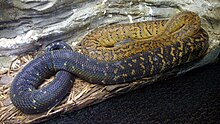
Jamaican boa

Jamaican parrotfish

Jamaican black-billed parrot

Jamaican swallowtail
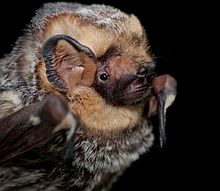
Jamaican hairy-tailed bat
Today, however, Jamaica is now the home to about 3,000 species of native flowering plants (of which over 1,000 are endemic and 200 are species of orchid), thousands of species of non-flowering flora, and about 20 botanical gardens, some of which are several hundred years old. Areas of heavy rainfall also contain stands of bamboo, ferns, ebony, mahogany, and rosewood. Cactus and similar dry-area plants are found along the south and southwest coastal area. Parts of the west and southwest consist of large grasslands, with scattered stands of trees.
Jamaican’s fauna, typical of the Caribbean, includes highly diversified wildlife with many endemic species. As with other oceanic islands, land mammals are mostly several species of bats of which at least three endemic species are found only in Cockpit Country, one of which is at-risk. Other species of bat include the fig-eating and hairy-tailed bats. The only non-bat native mammal extant in Jamaica is the Jamaican hutia, locally known as the coney. Introduced mammals such as wild boar and the small Asian mongoose are also common. Jamaica is also home to about 50 species of reptiles, the largest of which is the American crocodile; however, it is only present within the Black River and a few other areas. Lizards such as anoles, iguanas and snakes such as racers and the Jamaican boa (the largest snake on the island), are common in areas such as the Cockpit Country. None of Jamaica’s eight species of native snakes is venomous.
Jamaica is home to about 289 species of birds of which 27 are endemic including the endangered black-Billed parrots and the Jamaican blackbird, both of which are only found in Cockpit Country. It is also the indigenous home to four species of hummingbirds (three of which are found nowhere else in the world): the black-billed streamertail, the Jamaican mango, the Vervain hummingbird, and red-billed streamertails. The red-billed streamertail, known locally as the “doctor bird”, is Jamaica’s National Symbol. Other notable species include the Jamaican tody and the Greater flamingo,
Jamaican waters contain considerable resources of fresh-and saltwater fish. The chief varieties of saltwater fish are kingfish, jack, mackerel, whiting, bonito, and tuna. Fish that occasionally enter freshwater and estuarine environments include snook, jewfish, mangrove snapper, and mullets. Fish that spend the majority of their lives in Jamaica’s fresh waters include many species of livebearers, killifish, freshwater gobies, the mountain mullet, and the American eel. Tilapia have been introduced from Africa for aquaculture, and are very common. Also visible in the waters surrounding Jamaica are dolphins, parrotfish, and the endangered manatee.
Demographics
Jamaica’s population, 1961–2003
| Ethnic Group | % | Population |
|---|---|---|
| Black or Black Mixed | 92.1% | 2,661,965 |
| Mixed non-Black | 6.1% | 176,308 |
| Asian | 0.8% | 23,122 |
| Other | 0.4% | 11,561 |
| Unspecified | 0.7% | 20,232 |
Jamaica’s diverse ethnic roots is reflected in the national motto ‘Out of Many One People’. Most of the population of 2,812,000 (July 2018 est.) are of African or partially African descent, with many being able to trace their origins to the West African countries of Ghana and Nigeria. It is uncommon for Jamaicans to identify themselves by race as is prominent in other countries such as the United States, with most Jamaicans seeing Jamaican nationality as an identity in and of itself.
Along with the English and the Irish, the Scots are another group that has made a significant impact on the island. According to the Scotland Herald newspaper, Jamaica has more people using the Campbell surnames than the population of Scotland itself, and it also has the highest percentage of Scottish surnames outside of Scotland. Scottish surnames account for about 60% of the surnames in the Jamaican phone books. The first Jamaican inhabitants from Scotland were exiled “rebels”. Later, they would be followed by ambitious businessmen who spent time between their great country estates in Scotland and the island. As a result, many of the slave owning plantations on the island were owned by Scottish men, and thus a large number of mixed-race Jamaicans can claim Scottish ancestry. High immigration from Scotland continued until well after independence. Today, notable Scottish-Jamaicans include the businessman John Pringle, former American Secretary of State Colin Powell, and American actress Kerry Washington.
In recent years immigration has increased, coming mainly from China, Haiti, Cuba, Colombia, and Latin America; 20,000 Latin Americans reside in Jamaica. In 2016, Prime Minister Andrew Holness suggested making Spanish Jamaica’s second official language. About 7,000 Americans also reside in Jamaica. Notable Americans with connection to the island include fashion icon Ralph Lauren and philanthropist Daisy Soros.
Languages
Jamaica is regarded as a bilingual country, with two major languages in use by the population. The official language is English, which is “used in all domains of public life”, including the government, the legal system, the media, and education. However, the primary spoken language is an English-based creole called Jamaican Patois (or Patwa). The two exist in a dialect continuum, with speakers using a different register of speech depending on context and whom they are speaking to. ‘Pure’ Patois, though sometimes seen as merely a particularly aberrant dialect of English, is essentially mutually unintelligible to speakers of standard English and is best thought of a separate language.
Emigration
Many Jamaicans have emigrated to other countries, especially to the United Kingdom, the United States, and Canada. In the case of the United States, about 20,000 Jamaicans per year are granted permanent residence. There has also been emigration of Jamaicans to other Caribbeans countries such as Cuba, Puerto Rico, Guyana, and The Bahamas. It was estimated in 2004 that up to 2.5 million Jamaicans and Jamaican descendants live abroad.
Jamaicans in the United Kingdom number an estimated 800,000 making them by far the country’s largest African-Caribbean group. Large-scale migration from Jamaica to the UK occurred primarily in the 1950s and 1960s when the country was still under British rule.
Jamaican communities exist in most large UK cities. Concentrations of expatriate Jamaicans are quite considerable in numerous cities in the United States, including New York City, Buffalo, the Miami metro area, Atlanta, Chicago, Orlando, Tampa, Washington, D.C., Philadelphia, Hartford, Providence and Los Angeles. In Canada, the Jamaican population is centred in Toronto, with smaller communities in cities such as Hamilton, Montreal, Winnipeg, Vancouver and Ottawa. Jamaican Canadians comprise about 30% of the entire Black Canadian population.
Crime
When Jamaica gained independence in 1962, the murder rate was 3.9 per 100,000 inhabitants, one of the lowest in the world. By 2009, the rate was 62 per 100,000 inhabitants, one of the highest in the world. Gang violence became a serious problems, with organised crime being centred around Jamaican posses or ‘Yardies’. Jamaica has had one of the highest murder rates in the world for many years, according to UN estimates.
Many Jamaicans are hostile towards LGBT and intersex people, and mob attacks against gay people have been reported. Numerous high-profile dancehall and ragga artists have produced songs featuring explicitly homophobic lyrics. Male homosexuality is illegal and punishable by prison time.
Major cities
|
Largest cities or towns in Jamaica |
|||||||||
|---|---|---|---|---|---|---|---|---|---|
| Rank | Name | Parish | Pop. | ||||||
| 1 | Kingston | Kingston | 661,862 | ||||||
| 2 | Portmore | Saint Catherine | 182,153 | ||||||
| 3 | Spanish Town | Saint Catherine | 147,152 | ||||||
| 4 | Montego Bay | Saint James | 110,115 | ||||||
| 5 | May Pen | Clarendon | 61,548 | ||||||
| 6 | Mandeville | Manchester | 49,695 | ||||||
| 7 | Old Harbour | Saint Catherine | 28,912 | ||||||
| 8 | Savanna-la-Mar | Westmoreland | 22,633 | ||||||
| 9 | Ocho Rios | Saint Ann | 16,671 | ||||||
| 10 | Linstead | Saint Catherine | 15,231 | ||||||
Religion
Christianity is the largest religion practised in Jamaica. About 70% are Protestants; Roman Catholics are just 2% of the population.[11] According to the 2001 census, the country’s largest Protestant denominations are the Church of God (24%), Seventh-day Adventist Church (11%), Pentecostal (10%), Baptist (7%), Anglican (4%), United Church (2%), Methodist (2%), Moravian (1%) and Plymouth Brethren (1%). Bedwardism is a form of Christianity native to the island, sometime view as a separate faith. The Christian faith gained acceptance as British Christian abolitionists and Baptist missionaries joined educated former slaves in the struggle against slavery.
Culture

Bob Marley, the most famous reggae artist from Jamaica
Music
Though a small nation, Jamaican culture has a strong global presence. The musical genres reggae, ska, mento, rocksteady, dub, and, more recently, dancehall and ragga all originated in the island’s vibrant, popular urban recording industry. These have themselves gone on to influence numerous other genres, such as punk rock (through reggae and ska), dub poetry, New Wave, two-tone, reggaeton, jungle, drum and bass, dubstep, grime and American rap music. Some rappers, such as The Notorious B.I.G., Busta Rhymes, and Heavy D, are of Jamaican descent.
Cuisine
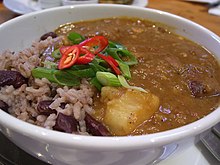
Jamaican curry goat with rice and peas
The island is famous for its Jamaican jerk spice, curries and rice and peas which is integral to Jamaican cuisine. Jamaica is also home to Red Stripe beer and Jamaican Blue Mountain Coffee.
Sport
Sport is an integral part of national life in Jamaica and the island’s athletes tend to perform to a standard well above what might ordinarily be expected of such a small country. While the most popular local sport is cricket, on the international stage Jamaicans have tended to do particularly well at track and field athletics.
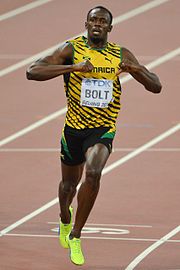
Usain Bolt is one of the most prominent sprinters in the world
Since independence, Jamaica has consistently produced world class athletes in track and field. In Jamaica involvement in athletics begins at a very young age and most high schools maintain rigorous athletics programs with their top athletes competing in national competitions (most notably the VMBS Girls and Boys Athletics Championships) and international meets (most notably the Penn Relays). In Jamaica it is not uncommon for young athletes to attain press coverage and national fame long before they arrive on the international athletics stage.
Over the past six decades Jamaica has produced dozens of world class sprinters including Olympic and World Champion Usain Bolt, world record holder in the 100m for men at 9.58s, and 200m for men at 19.19s.
Jamaica has also produced several world class amateur and professional boxers including Trevor Berbick and Mike McCallum. First-generation Jamaican athletes have continued to make a significant impact on the sport internationally, especially in the United Kingdom where the list of top British boxers born in Jamaica or of Jamaican parents includes Lloyd Honeyghan, Chris Eubank, Audley Harrison, David Haye, Lennox Lewis and Frank Bruno, Donovan “Razor” Ruddock, Mike Tyson, and Floyd Mayweather Jr., whose maternal grandfather is Jamaican.
Association football and horse-racing are other popular sports in Jamaica. The national football team qualified for the 1998 FIFA World Cup. Horse racing was Jamaica’s first sport. It was brought in the 1700s by British immigrants to satisfy their longing for their favorite pastime back at home. During slavery, the Afro-Jamaican slaves were considered the best horse jockeys. Today, horse racing provides jobs for about 20,000 people including horse breeders, groomers, and trainers.
Race car driving is also a popular sport in Jamaica with several car racing tracks and racing associations across the country.
The Jamaica national bobsled team was once a serious contender in the Winter Olympics, beating many well-established teams. Chess and basketball are widely played in Jamaica and are supported by the Jamaica Chess Federation (JCF) and the Jamaica Basketball Federation (JBF), respectively. Netball is also very popular on the island, with the Jamaica national netball team called The Sunshine Girls consistently ranking in the top five in the world.
According to ESPN, the highest paid Jamaican professional athlete in 2011 was Justin Masterson, starting pitcher for the Cleveland Indians.
Education
The emancipation of the slaves heralded the establishment of an education system for the masses. Prior to emancipation there were few schools for educating locals and many sent their children off to England to access quality education. After emancipation the West Indian Commission granted a sum of money to establish Elementary Schools, now known as All Age Schools. Most of these schools were established by the churches. This was the genesis of the modern Jamaican school system.
Presently the following categories of schools exist:
- Early childhood – Basic, infant and privately operated pre-school. Age cohort: 2 – 5 years.
- Primary – Publicly and privately owned (privately owned being called preparatory schools). Ages 3 – 12 years.
- Secondary – Publicly and privately owned. Ages 10 – 19 years. The high schools in Jamaica may be either single-sex or co-educational institutions, and many schools follow the traditional English grammar school model used throughout the British West Indies.
- Tertiary – There are five local universities: the University of the West Indies (Mona Campus); the University of Technology, Jamaica, formerly The College of Art Science and Technology (CAST); the Northern Caribbean University, formerly West Indies College; the University of the Commonwealth Caribbean, formerly the University College of The Caribbean; and the International University of the Caribbean.
Education is free from the early childhood to secondary levels. There are also opportunities for those who cannot afford further education in the vocational arena, through the Human Employment and Resource.
Students are taught Spanish in school from the primary level upwards; about 40–45% of educated people in Jamaica knows some form of Spanish.
Economy
Jamaica is a mixed economy with both state enterprises and private sector businesses. Major sectors of the Jamaican economy include agriculture, mining, manufacturing, tourism, petroleum refining, financial and insurance services. Tourism and mining are the leading earners of foreign exchange. Half the Jamaican economy relies on services, with half of its income coming from services such as tourism.
Jamaica’s economy grew strongly after the years of independence, but then stagnated in the 1980s, due to the heavy falls in price of bauxite and fluctuations in the price of agriculture. The financial sector was troubled in 1994, with many banks and insurance companies suffering heavy losses and liquidity problems.
In 1996 and 1997 there was a decrease in GDP largely due to significant problems in the financial sector and, in 1997, a severe island-wide drought (the worst in 70 years) and hurricane that drastically reduced agricultural production.
Recent economic performance shows the Jamaican economy is recovering. Agricultural production, an important engine of growth increased to 5.5% in 2001 compared to the corresponding period in 2000, signaling the first positive growth rate in the sector since January 1997. In 2018, Jamaica reported a 7.9% increase in corn, 6.1% increase in plantains, 10.4% increase in bananas, 2.2% increase in pineapples, 13.3% increase in dasheen, 24.9% increase in coconuts, and a 10.6% increase in whole milk production. Jamaica is the fifth-largest exporter of bauxite in the world, after Australia, China, Brazil and Guinea. The country also exports limestone, of which it holds large deposits.
Tourism, which is the largest foreign exchange earner, showed improvement as well. In 1999 the total visitor arrivals was 2 million, an increase of 100,000 from the previous year. Since 2017, Jamaica’s tourism has risen exponentially, rising to 4.3 million average tourists per year. Jamaica’s largest tourist markets are from North America, South America, and Europe. In 2017, Jamaica recorded a 91.3% increase in stopover visitors from Southern and Western Europe (and a 41% increase in stopover arrivals from January to September 2017 over the same period from the previous year) with Germany, Portugal and Spain registering the highest percentage gains.
Jamaica’s agricultural exports are sugar, bananas, cocoa, coconut, molasses oranges, limes, grapefruit, rum, yams, allspice (of which it is the world’s largest and “most exceptional quality” exporter), and Blue Mountain Coffee which is considered a world-renowned gourmet brand.
That’s all folks! Official end of the RLR – Randy Lewis Racing Trackchaser Report
This is not my video but it’s still pretty cool. Racing in Jamaica!
Check out my photo album below. Just click the link
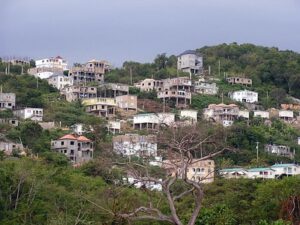
A quick but fun trackchasing trip to Jamaica mon!

